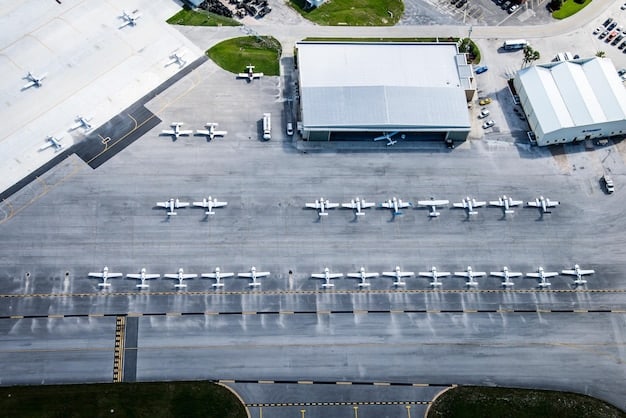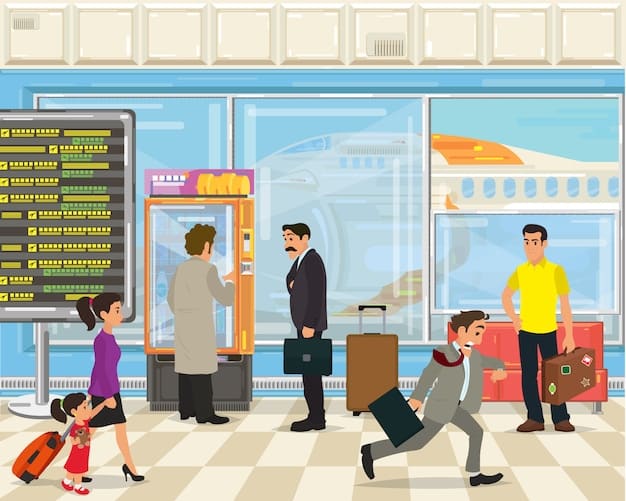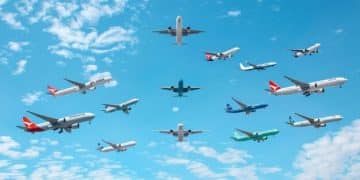Airline Mergers & Acquisitions: Understanding the Consolidation Trend

Airline mergers and acquisitions are reshaping the aviation landscape, driven by factors like cost reduction, increased market share, and enhanced operational efficiency, ultimately impacting travelers and industry dynamics.
The airline industry is no stranger to turbulence, and one constant in its complex skies is the trend of airline mergers and acquisitions: what’s driving the latest consolidation trend? These strategic moves, where airlines combine forces, have significant implications for passengers, competition, and the overall health of the aviation sector. Let’s delve into the factors fueling this persistent consolidation.
Understanding Airline Mergers and Acquisitions
Airline mergers and acquisitions involve the combining of two or more airline companies. This can take many forms, from a complete absorption of one airline by another to a more collaborative merger of equals. These actions dramatically reshape the competitive landscape within the aviation industry. The implications extend far beyond corporate boardrooms, impacting everything from ticket prices to route networks.
Types of Airline Mergers
Airline mergers can be classified into several types, each with its own unique structure and objectives.
- Horizontal Mergers: These involve companies that compete directly in the same market, such as two airlines with overlapping route networks.
- Vertical Mergers: These occur between companies at different stages of the supply chain, such as an airline and an aircraft manufacturer.
- Conglomerate Mergers: These involve companies in unrelated industries, which are less common in the airline sector.
Understanding these different types of mergers helps to clarify the motivations and potential impacts of airline consolidation.

The Historical Context of Airline Mergers
Airline mergers are nothing new. The industry has undergone several waves of consolidation throughout its history. In the United States, major mergers in recent decades include the combination of Delta and Northwest, United and Continental, and American Airlines and US Airways. These mergers aimed to create larger, more efficient airlines capable of competing in the global market.
Airline consolidation often follows periods of economic downturn or intense competition. When airlines struggle to remain profitable on their own, mergers can provide a lifeline, allowing them to pool resources and reduce costs.
In summary, airline mergers are a recurring feature of the aviation industry, driven by a complex interplay of economic, competitive, and regulatory factors. As airlines navigate an ever-changing landscape, consolidation remains a key strategy for survival and growth.
Economic Pressures and Market Dynamics
The airline industry is notably susceptible to economic fluctuations. Therefore, economic pressures and market dynamics are key stimuli for mergers and acquisitions. When airlines face financial setbacks, combining with another airline offers a pathway to stability. Moreover, the ever-shifting demands and preferences of travelers lead airlines to adapt and consolidate.
Fuel Price Volatility
Fuel is one of the largest expenses for airlines, and spikes in fuel prices can significantly impact profitability. When fuel prices rise, airlines may look to mergers as a way to cut costs and improve efficiency.
By merging, airlines can achieve economies of scale in fuel purchasing and hedging strategies, potentially reducing their exposure to price volatility.
Intense Competition
The airline industry is highly competitive, with numerous carriers vying for passengers. This intense competition can lead to fare wars and reduced profit margins, making it difficult for individual airlines to thrive.
In response, airlines may seek to merge with competitors to reduce excess capacity, eliminate overlapping routes, and gain greater pricing power.

Fluctuations in Passenger Demand
Passenger demand is another critical factor driving airline mergers. Economic downturns, geopolitical events, and seasonal variations can all impact the number of people flying, affecting airline revenue.
- Economic Downturns: Recessions typically lead to a decline in both leisure and business travel, putting pressure on airlines’ bottom lines.
- Geopolitical Events: Events such as terrorist attacks or pandemics can disrupt travel patterns and reduce demand.
- Seasonal Variations: Airlines experience peak travel seasons (e.g., summer, holidays) and off-peak seasons, which can create revenue imbalances.
Mergers can help airlines better manage these fluctuations by diversifying their route networks and customer base.
Economic pressures and market dynamics profoundly influence airline mergers and acquisitions. The need to manage fuel costs, navigate intense competition, and respond to fluctuations in passenger demand makes consolidation an appealing strategy for many airlines.
Regulatory Environment and Government Policies
The regulatory environment plays a crucial role in shaping airline mergers. Government policies and regulatory bodies scrutinize proposed mergers to ensure they do not harm competition or the interests of consumers. Antitrust laws are a primary concern, aiming to prevent monopolies and protect fair competition.
Antitrust Scrutiny
Mergers that significantly reduce competition in the airline industry are subject to intense antitrust scrutiny. Regulators, such as the Department of Justice (DOJ) in the United States, carefully evaluate the potential impact of a merger on prices, routes, and service quality.
If regulators determine that a merger would create an anti-competitive environment, they may block the deal or require the merging airlines to make concessions, such as divesting routes or airport slots.
International Agreements
International agreements and open skies policies also influence cross-border airline mergers and alliances. These agreements govern the rights of airlines to fly between countries and can either facilitate or hinder consolidation efforts.
Open skies agreements, which promote liberalized air transport, can encourage airlines from different countries to form partnerships or even merge, expanding their global reach.
Government Support and Intervention
In some cases, governments may provide support or intervene in airline mergers to protect jobs, maintain essential air services, or ensure the survival of strategically important airlines.
- Financial Assistance: Governments may offer loans, grants, or other forms of financial assistance to airlines facing financial difficulties, which can influence their merger decisions.
- Merger Approvals: Governments have the power to approve or reject proposed mergers, taking into account the broader economic and social implications.
- National Interests: Governments may prioritize the preservation of a national airline, even if it means supporting a merger that might otherwise raise competitive concerns.
In conclusion, the regulatory environment and government policies greatly influence airline mergers. Antitrust laws, international agreements, and government support all play a role in shaping the landscape of airline consolidation.
Operational Synergies and Cost Reduction
One of the main drivers behind airline mergers is the potential for operational synergies and cost reduction. By combining operations, airlines can streamline processes, eliminate redundancies, and achieve economies of scale, leading to significant cost savings.
Route Network Optimization
Merging airlines can optimize their route networks by eliminating overlapping routes and expanding their reach to new markets. This can result in increased efficiency and higher load factors.
A combined airline may be able to offer more nonstop flights, better connections, and a wider range of destinations, enhancing the customer experience.
Fleet Standardization
Another area where mergers can generate cost savings is fleet standardization. By operating a more uniform fleet of aircraft, airlines can reduce maintenance costs, simplify training, and improve operational efficiency.
Standardizing the fleet can also lead to better utilization of aircraft, as well as greater flexibility in deploying planes to different routes.
Economies of Scale
Mergers offer the chance for economies of scale. Combining resources, infrastructure, and personnel can reduce overhead expenses and improve profitability. This can be seen across various aspects of the business.
- Purchasing Power: A larger airline can negotiate better deals with suppliers, such as aircraft manufacturers, fuel providers, and catering companies.
- Administrative Efficiencies: Consolidating administrative functions, such as finance, human resources, and marketing, can reduce staffing costs and improve efficiency.
- IT Infrastructure: Integrating IT systems and infrastructure can eliminate redundant expenses and improve data management.
In summary, operational synergies and cost reduction are key incentives for mergers. Route network optimization, fleet standardization, and economies of scale all contribute to the potential for significant cost savings and improved operational performance.
Impact on Passengers and Competition
Airline mergers have a profound impact on passengers and competition within the industry. While mergers can lead to some benefits, such as expanded route networks and improved service, they also raise concerns about reduced competition and higher fares.
Potential Benefits for Passengers
Mergers can offer passengers several potential benefits. For example, expanded route networks can provide more travel options and better connections. Also, combined airlines may invest in upgrading their products and services.
Passengers may also benefit from increased loyalty program benefits and reciprocal frequent flyer agreements.
Concerns about Reduced Competition
The primary concern about airline mergers is the potential for reduced competition. Fewer airlines in the market may lead to higher fares, fewer choices, and lower service quality.
According to the U.S. Government Accountability Office, airline passengers may have suffered financially as a result of past mergers. More research is needed on the topic.
Impact on Fares and Service Quality
Studies on the impact of airline mergers on fares have yielded mixed results. Some studies have found that fares tend to increase after a merger, while others have found little or no significant impact.
- Fare Increases: In markets where the merged airline has a dominant market share, fares may rise due to reduced competition.
- Service Quality: Service quality can also be affected by mergers. Some airlines may cut costs by reducing amenities, increasing fees, or decreasing staffing levels.
- Consumer Choice: Mergers can limit consumer choice by reducing the number of airlines serving a particular route.
In conclusion, airline mergers have significant implications for passengers and competition. While mergers can offer potential benefits, concerns about reduced competition, higher fares, and diminished service quality remain.
Future Trends in Airline Consolidation
Looking ahead, several trends are poised to shape the future of airline consolidation. Globalization, technological advancements, and evolving consumer preferences will all play a role in driving further consolidation in the industry.
Globalization and Cross-Border Alliances
Globalization is encouraging airlines to form cross-border alliances and partnerships. These alliances allow airlines to expand their global reach, share costs, and offer seamless travel experiences to passengers.
Another form of alliance that can be seen in the industry is airline codesharing. This permits an airline to book its passengers on another carrier’s flights. It’s beneficial because it allows an airline to expand its reach without employing more planes or routes.
Technological Advancements
Technological advancements are transforming the airline industry, creating new opportunities for consolidation and collaboration. Airlines are investing in digital technologies to improve efficiency.
Such technology permits airlines to better understand their customers’ preferences. As a result, they can offer travelers better deals and experiences that are personalized to them.
Evolving Consumer Preferences
Evolving consumer preferences are also driving changes in the airline industry. Passengers are increasingly demanding more personalized experiences, greater flexibility, and more value for their money.
- Personalization: Airlines are using data analytics to personalize their offerings, tailoring products and services to individual customer preferences.
- Flexibility: Passengers are seeking more flexible booking options, such as the ability to change or cancel flights without penalty.
- Value: Passengers are increasingly price-sensitive, seeking the best value for their money.
Moving forward, globalization, innovations, and customer preferences are poised to influence integration in the airline industry. Airlines that can quickly adapt to these changes will be best positioned for successful consolidation.
| Key Point | Brief Description |
|---|---|
| 🤝 Merger Types | Horizontal, vertical, and conglomerate mergers each have distinct impacts. |
| 💰 Economic Drivers | Fuel prices and passenger demand greatly influence merger activities. |
| ⚖️ Regulatory Role | Antitrust scrutiny and government policies shape merger outcomes. |
| 📉 Operation Synergy | Route optimization and fleet standardization lead to efficiency. |
Frequently Asked Questions
Airline mergers and acquisitions refer to the combining of two or more airline companies. This can range from one airline absorbing another to a collaborative merger of equals, reshaping the competitive landscape.
Airlines merge or get acquired for reasons such as cutting costs, boosting market share, and making operations run smoother. This can help them do better in the tough aviation business.
Regulatory bodies, like the Department of Justice, assess airline mergers to ensure they do not hurt competition or consumers. They may require concessions to approve a deal.
Travelers should be aware of potential changes to routes, fares, and service after a merger. While some benefits exist, reduced competition can lead to increased costs and fewer options.
Government policies significantly influence airline mergers. They can block or support deals to protect jobs, maintain services, or preserve national interests, impacting the industry’s consolidation landscape.
Conclusion
In conclusion, airline mergers and acquisitions are complex events driven by a confluence of economic pressures, regulatory environments, and strategic objectives. While such consolidation can lead to operational synergies and expanded networks, careful consideration of the impacts on competition and passenger welfare remains crucial for the future of the aviation industry.





